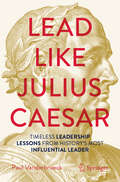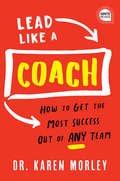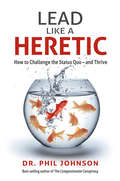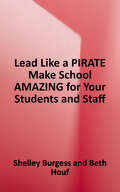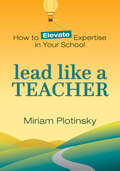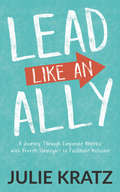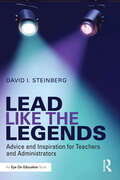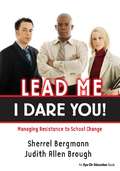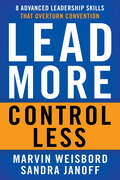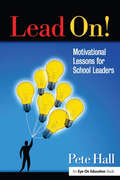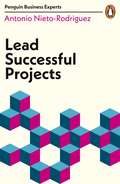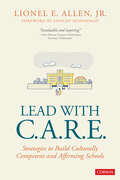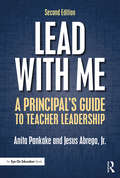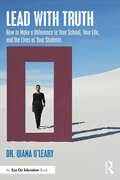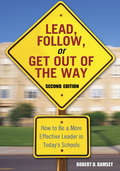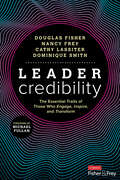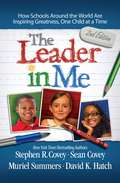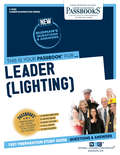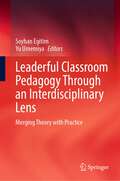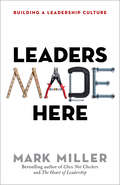- Table View
- List View
Lead Like Julius Caesar: Timeless Leadership Lessons from History's Most Influential Leader
by Paul VanderbroeckDiscover the legendary life and career of Julius Caesar in this insightful and thought-provoking book that breaks down the bold strategies, leadership skills, and motivations behind his rise to power. Beyond his triumphs, the book examines the cautionary tale of his downfall, offering timeless lessons for managers, leaders, and business students to reflect on and benchmark their careers. Through a modern lens – by applying leadership theories – this book explores Caesar's personal traits, relationships, and decisions that shaped his leadership, providing insights into his competencies and the factors behind his meteoric rise. It's a valuable case study for organizations aiming to develop strong leaders and teams, making it a must-read for history enthusiasts, professionals, and anyone seeking practical strategies for success. For managers, leaders, professionals, and business students alike, this book offers a unique opportunity to reflect on their careers and benchmark their success and ambition against one of the greatest leaders of all time.
Lead Like a Coach: How to Get the Most Success Out of ANY Team (Ignite Reads)
by Karen MorleyBecome the Mentor You Always WISHED You'd HadAll good coaches know that in order for their star players to perform at their best—they need to be given an opportunity to score! Are you allowing your team to succeed, or keeping the control for yourself?If you're someone who cares about the success of the people you lead and want to make a positive impact on their stakeholders, their families, and their communities... then this book is perfect for you! Packed with practical strategies and case studies, Karen Morley's Lead Like a Coach makes it easy for anyone to be the leader they aspire to be—and how to help their people shine!By letting your teammates learn, grow, and triumph creatively and independently...your shared success is guaranteed.
Lead Like a Heretic
by Dr Phil JohnsonIn his 2016 ground-breaking leadership book, The Compassionate Conspiracy, Dr. Phil Johnson redefined "conspirators" as "radical global servant-leaders" who work together to tackle the biggest problems we face today. Now, in Lead Like a Heretic, he revolutionises the meaning of "heretic" and confronts today's global leadership crisis: the failure of leaders at all levels to engage, energise, and empower their followers. This book explores the heretical process of daring leadership and change, providing famous examples from business, government, education, sports, professional associations, and non-profit organisations.
Lead Like a Pirate: Make School Amazing for Your Students and Staff
by Shelley Burgess Beth HoufAre You a Treasure Seeker? Pirates are on a constant quest for riches, but PIRATE Leaders seek even greater rewards: amazing schools, engaged students, and empowered educators who know they are making a difference. <P><P>In Lead Like a PIRATE, education leaders Shelley Burgess and Beth Houf map out the character traits necessary to captain a school or district. You'll learn where to find the treasure that's already in your classrooms and schools—and how to bring out the very best in your educators. - What does it take to be a PIRATE Leader? - Passion--both professional and personal - A willingness to Immerse yourself in your work - Good Rapport with your staff, students, and community - The courage to Ask questions and Analyze what is and isn't working - The determination to seek positive Transformation - And the kind of Enthusiasm that gets others excited about education <P><P>The ultimate goal for any education leader is to create schools and districts where students and staff are knocking down the doors to get in rather than out. This book will equip and encourage you to be relentless in your quest to make school amazing for your students, staff, parents, and communities. Are you ready to set sail?
Lead Like a Teacher: How to Elevate Expertise in Your School
by Miriam PlotinskyFor the sake of students, close the empathy gap between the classroom and the front office. Far too often, teachers and administrators are adversaries within a school or district and display a mutual distrust and disrespect for each other’s perspectives. Yet when this dissonance can be overcome, the result is a more-harmonious school environment that promotes student achievement. In Lead Like a Teacher, instructional specialist Miriam Plotinsky urges secondary school administrators to lead more effectively by actively listening to teachers and welcoming their expertise. Each chapter examines one of nine key aspects of leadership and offers specific, creative solutions to the complex challenge of empowering change. Moving from a micro to a macro focus as the book progresses—from classroom instruction to schoolwide initiatives—Plotinsky provides administrators with the tools to build and maintain collaborative leadership structures. This thoughtful approach to secondary leadership provides an actionable plan to dismantle some of the biggest barriers to achieving school excellence.
Lead Like an Ally: A Journey Through Corporate America with Proven Strategies to Facilitate Inclusion
by Julie KratzLead Like an Ally facilitates positive change by including six leadership strategies, such as clean up the culture, stretch talent equally, establish ally networks, manage meeting behavior, promote belonging, and measure success. Leaders, now more than ever, are wrestling with how to attract and retain diverse talent and be inclusive leaders. Despite the best of intentions, very few organizations are reaching their equality goals, even those deeply committed to diversity and inclusion. Leaders have the biggest impact on culture, yet they need tools to do this. Lead Like an Ally provides proven strategies, teaching leaders how to be inclusive with its companion manager tool kit to facilitate sustained success. Within its pages, Lead Like an Ally:Teaches leaders how to be inclusive through an entertaining fableProvides a window into the woman’s journey through Corporate America and the unique challenges women face Facilitates inclusive cultures with proven strategies for positive change Includes a manager tool kit and checklist to take action right away
Lead Like the Legends: Advice and Inspiration for Teachers and Administrators
by David I. SteinbergBased on the popular presentation of the same name, Lead Like the Legends uses the inspiring words of musical legends to help teachers and administrators learn the principles of effective leadership. The book is organized around 14 musical greats, including Ray Charles, Duke Ellington, Marian Anderson, Carlos Santana, The Beatles, Bob Dylan, and Louis Armstrong. As you examine the words of wisdom from these artists, you’ll learn the keys to strong leadership, such as… being sincere; accepting no limits; leading with imagination; leading by participating; being daring and high energy; using teamwork; and being yourself. Each chapter includes motivational stories and examples from school leaders across the country, as well as reflection activities, self-assessments, and planning tools to help you implement the ideas. Whether you’re a teacher looking to enhance your skills or an administrator in charge of managing a school or district, you’ll come away from the book with fresh ideas and inspiration to help you on your journey.
Lead Me, I Dare You!: Managing Resistance to School Change
by Sherrell Bergmann Judith BroughThis original book shows you how to understand and collaborate with the most difficult members of your staff. Tied together by real-world "success stories" about school change and succinct leadership tips, the parctical advice in this book is supported by research and is presented in a conversational style.
Lead More, Control Less: 8 Advanced Leadership Skills That Overturn Convention
by Marvin Weisbord Sandra JanoffUnleash Commitment, Initiative, and InnovationIn their decades of leading groups all over the world, Marvin Weisbord and Sandra Janoff discovered they could get superior results by creating an unconventional approach to leadership. Leaders still need to get everyone aligned around the same goals. But to maximize energy, creativity, and productivity, they gain more by focusing on structure rather than behavior, enabling people to take responsibility and manage themselves. Lead More, Control Less describes eight essential skills for establishing a culture of autonomy and self-leadership. Using examples and case studies, Weisbord and Janoff describe how leaders can share responsibility, defuse group conflicts, show everyone the big picture, and more. With this approach, leaders truly gain more control by giving it up.
Lead On!: Motivational Lessons for School Leaders
by Pete HallEvery school leader will benefit from this must-have book by award-winning educator Pete Hall. In it he shares his wisdom, insights, and lessons lived and learned with educators at all stages of their careers. His lively, readable style makes it easy to follow his practical tips and strategies for taking action, goal-setting, motivating others, gaining perspective, and so much more! The ideas for motivational strategies jump out from the pages, and combined with the common-sense approach, make this a go-to, appealing reference for educators to use over and over again. Timeless lessons in this book include: Making It Fun Again Hope Ain't a Strategy The Power of Positive Phrasing And many more!
Lead Successful Projects (Penguin Business Experts Series)
by Antonio Nieto-RodriguezAre you struggling to juggle multiple projects? Do you often lose control of your budget? Does communicating your progress to the rest of your team cause you undue stress? Project management is an essential skill for anyone who needs to get things done in any organisation, and is absolutely critical for anyone leading strategic change. In Lead Successful Projects, the Penguin Business Expert guide, Antonio Nieto-Rodriguez introduces a simplified but strategic approach to project management developed over the last 20 years coaching executives, managers and MBAs.Learn how to break down your project into manageable elements, define smart goals and meet them in this concise and practical guide to project success.
Lead With C.A.R.E.: Strategies to Build Culturally Competent and Affirming Schools
by Lionel E. AllenA framework for the courageous school leadership our students deserve. From the foreword by Gholdy Muhammad… "In Leading With C.A.R.E., Dr. Allen provides a way to disrupt the harms that systems, teachers, and leaders may inflict on children. He uses the richness of his personal and professional experiences to speak to the true purpose and power of schools, which is to disrupt disparities and affirm students’ cultural identities and brilliance. In doing so, Dr. Allen reminds educators that we must examine the structures of education historically and in the present so that we can dismantle harmful practices. The framework of C.A.R.E. presented here guides educators to lead with Culturally Responsiveness in teaching and learning, while Affirming children’s identities, and building positive Relationships with youth. Dr. Allen posits that this leads to spaces of Empowerment. This book provides the what, the why and importantly, the how. The C.A.R.E. framework helps leaders center the genius and joy of youth and teachers, while recognizing the social times we live in and elevating the education of children, especially those who have been historically excluded in schooling and in society. The framework provides a way forward for leaders to lead differently—with care, belonging, and excellence; providing every child with what they deeply deserve." With learning goals, summaries, and reflection questions included in each chapter, this guide offers actionable strategies educators can use to establish a culture that prioritizes students’ experiences and affirms their identities.
Lead With C.A.R.E.: Strategies to Build Culturally Competent and Affirming Schools
by Lionel E. AllenA framework for the courageous school leadership our students deserve. From the foreword by Gholdy Muhammad… "In Leading With C.A.R.E., Dr. Allen provides a way to disrupt the harms that systems, teachers, and leaders may inflict on children. He uses the richness of his personal and professional experiences to speak to the true purpose and power of schools, which is to disrupt disparities and affirm students’ cultural identities and brilliance. In doing so, Dr. Allen reminds educators that we must examine the structures of education historically and in the present so that we can dismantle harmful practices. The framework of C.A.R.E. presented here guides educators to lead with Culturally Responsiveness in teaching and learning, while Affirming children’s identities, and building positive Relationships with youth. Dr. Allen posits that this leads to spaces of Empowerment. This book provides the what, the why and importantly, the how. The C.A.R.E. framework helps leaders center the genius and joy of youth and teachers, while recognizing the social times we live in and elevating the education of children, especially those who have been historically excluded in schooling and in society. The framework provides a way forward for leaders to lead differently—with care, belonging, and excellence; providing every child with what they deeply deserve." With learning goals, summaries, and reflection questions included in each chapter, this guide offers actionable strategies educators can use to establish a culture that prioritizes students’ experiences and affirms their identities.
Lead the Way: 24 Lessons in Leadership for After School Program Directors
by Paul YoungLead the Way provides short, self-guided overviews that both aspiring and practicing after school professionals need to thrive in their roles. The 24 fundamental insights and strategies can be used as professional development topics with after school program staff, laying the foundation for the program to recruit, retain, and grown effective leaders.
Lead with Me: A Principal's Guide to Teacher Leadership
by Anita Pankake Chuey AbregoLead With Me, 2nd Edition provides courageous principals with the tools for partnering with teachers in the student learning and improvement process. This practical guide explains the skills teacher leaders need and offers advice for principals who wish to engage teachers in learning these skills. Packed with stories and examples from educators in the field, this second edition explores how to: Build mutual trust and accountability with teachers and faculty Encourage and facilitate professional development Carefully manage the distribution of power and authority by involving faculty members in decision-making. The revised second edition provides a variety of helpful tools—PowerPoint presentations, reflection questions, activities for professional learning sessions, and annotated lists of additional resources—that can be downloaded as eResources: www.routledge.com/books/details/9781138785588.
Lead with Truth: How to Make a Difference in Your School, Your Life, and the Lives of Your Students
by Qiana O'LearyThe sacrificial nature of juggling instructional, operational, managerial, and collegial goals often leaves school leaders feeling so desperate to resolve conflicts that they lose self, abandoning their core values and forgetting their "why." In this timely and impactful resource, author and professor "Dr. O" draws on her own leadership journey– a journey where she remained true to her beliefs and commitment to serve BIPOC communities, even when that meant choosing the road less traveled--offering nine anchor principles to help guide educational leaders in returning to their core values; communicate and build trusting relationships with staff members, students, and parents; and recognize their self-worth beyond their role on school campuses. Lead with Truth is an interactive text that invites you to identify learning objectives and reflect on guided questions throughout the chapters, each of which ends in activities geared to help you make personal connections with the content. This engaging resource is for current and aspiring school leaders who aim to make lifelong impacts and transform their practice, while remaining true to their own beliefs.
Lead, Follow, or Get Out of the Way: How to Be a More Effective Leader in Today's Schools
by Robert D. RamseyBest-selling author Robert Ramsey gives you just what you need to avoid "simply managing" and to become a true leader instead!
Leader Credibility: The Essential Traits of Those Who Engage, Inspire, and Transform
by Douglas Fisher Nancy Frey Dominique Smith Cathy J. LassiterPassion, vision, relatability—can we ever quantify the facets of successful leadership? Is there sufficient "there-there" behind these feel-good words to transform a school into a culture of learning and bold hope? Yes, and yes! Inspired by John Hattie’s impressive research, Fisher, Frey, Lassiter, and Smith bring their trademark clarity to turn aspiration into energized action. For each of the five components that all effective leaders possess—trustworthiness, competence, dynamism, immediacy, and forward-thinking—leaders learn the first steps and bold leaps to mentor others. Each chapter abounds with professional development tools, including: Self-assessments so you know your baseline Pause and ponder questions to envision change REAL features to lead with alacrity Checklists to stay focused and strategic Relevant research to assimilate and share Now more than ever, schools need to be places where openness and trust are baked into every hallway hello and every meeting, so collective talents can take us farther than we ever imagined. Let Leader Credibility be your guide to steering others to that greatness.
Leader Credibility: The Essential Traits of Those Who Engage, Inspire, and Transform
by Douglas Fisher Nancy Frey Dominique Smith Cathy J. LassiterPassion, vision, relatability—can we ever quantify the facets of successful leadership? Is there sufficient "there-there" behind these feel-good words to transform a school into a culture of learning and bold hope? Yes, and yes! Inspired by John Hattie’s impressive research, Fisher, Frey, Lassiter, and Smith bring their trademark clarity to turn aspiration into energized action. For each of the five components that all effective leaders possess—trustworthiness, competence, dynamism, immediacy, and forward-thinking—leaders learn the first steps and bold leaps to mentor others. Each chapter abounds with professional development tools, including: Self-assessments so you know your baseline Pause and ponder questions to envision change REAL features to lead with alacrity Checklists to stay focused and strategic Relevant research to assimilate and share Now more than ever, schools need to be places where openness and trust are baked into every hallway hello and every meeting, so collective talents can take us farther than we ever imagined. Let Leader Credibility be your guide to steering others to that greatness.
Leader Ready: Four Pathways to Prepare Aspiring School Leaders
by Vince Bustamante Timothy CusackThe solution for preparing excellent school leaders is right in front of you. The best way to prepare aspiring leaders for principalship is to offer hands-on opportunities to develop the skills they’ll need when they’re in charge. Being a principal calls for originality, innovation, and the ability to work under pressure. Yet so few assistant principals and other aspiring leaders actually get to develop these competencies in meaningful ways that prepare them to lead a school with confidence. Leader Ready presents a framework that walks aspiring school leaders along the path to strong and independent principalship by using a mix of professional knowledge, modeling, coaching, guided experiences, and mastery experiences. Full of processes, action steps, and examples from the field, features include; A research-based plan for creating better conditions for aspiring leaders Guidance for achieving systemic professional growth throughout the school year Analysis of school-leadership standards to inform practice Voices of leaders, aspiring leaders, and experts from the field
Leader Ready: Four Pathways to Prepare Aspiring School Leaders
by Vince Bustamante Timothy CusackThe solution for preparing excellent school leaders is right in front of you. The best way to prepare aspiring leaders for principalship is to offer hands-on opportunities to develop the skills they’ll need when they’re in charge. Being a principal calls for originality, innovation, and the ability to work under pressure. Yet so few assistant principals and other aspiring leaders actually get to develop these competencies in meaningful ways that prepare them to lead a school with confidence. Leader Ready presents a framework that walks aspiring school leaders along the path to strong and independent principalship by using a mix of professional knowledge, modeling, coaching, guided experiences, and mastery experiences. Full of processes, action steps, and examples from the field, features include; A research-based plan for creating better conditions for aspiring leaders Guidance for achieving systemic professional growth throughout the school year Analysis of school-leadership standards to inform practice Voices of leaders, aspiring leaders, and experts from the field
Leader in Me: How Schools Around the World Are Inspiring Greatness, One Child at a Time
by Stephen R. CoveyFrom the multimillion-copy bestselling author of The 7 Habits of Highly Effective People, Dr. Stephen R. Covey illustrates how his principles of leadership can be applied to children of all ages. In today&’s world, we are inundated with information about who to be, what to do, and how to live. But what if there was a way to learn not just what to think about, but how to think? A program that taught young people how to manage priorities, focus on goals, and be a positive influence in their schools? The Leader in Me is that program. In this bestseller, Stephen R. Covey took the 7 Habits that have already changed the lives of millions of readers and showed that even young children can use them as they develop. These habits are being adapted by schools around the country in leadership programs, most famously at the A.B Combs Elementary school in Raleigh. Not only do the programs work, but they work better than anyone could have imagined. This book is full of examples of how the students blossom under the program—from the classroom that decided to form a support group for one of their classmates who had behavioral problems to the fourth grader who overcame his fear of public speaking and took his class to see him compete in a national story telling competition. Perfect for individuals and corporations alike, The Leader in Me shows how easy it is to incorporate these skills into daily life so kids of all ages can be more effective, goal-oriented, and successful.
Leader: Passbooks Study Guide (Career Examination Series #C-669)
by National Learning CorporationThe Leader (Lighting) Passbook® prepares you for your test by allowing you to take practice exams in the subjects you need to study. It provides hundreds of questions and answers in the areas that will likely be covered on your upcoming exam.
Leaderful Classroom Pedagogy Through an Interdisciplinary Lens: Merging Theory with Practice
by Soyhan Egitim Yu UmemiyaThis book focuses on the impact of teachers’ leadership identity on their pedagogical and class management choices and proposes a new pedagogical framework, leaderful classroom practices which emerged through collective, concurrent, collaborative, and compassionate interactions between the teacher and students. The interdisciplinary aspect of the book appeals to a wide range of readers from different disciplines and gives readers the opportunity to take a moment and reflect on their leadership identity, recognize the limitations of their practices, and adopt a leaderful pedagogy in their respective disciplines. Establishing an open, democratic, and participatory learning environment for all learners is a major leadership responsibility of teachers, and this book demonstrates how to accomplish this mission both in theory and practice.
Leaders Made Here: Building a Leadership Culture (The High Performance Series #2)
by Mark MillerLeaders Made HereGreat leaders create great organizations. However, a scarcity of leaders today means a shortfall in performance tomorrow. Don't gamble with your company's future!You don't need to hope that leaders emerge from the ranks or that search firms can find the leaders you need in a timely fashion. Hope is not a strategy! You can build an organizational culture that will ensure your leadership pipeline is full and flowing. Bestselling author and Chick-fil-A executive Mark Miller describes how to nurture leaders throughout the organization, from the front lines to the executive ranks. Leaders Made Here outlines a clear and replicable approach to creating the leadership bench every organization needs. To bring his ideas to life, Miller uses the story of Blake, a new CEO, and Charles and old friend and colleague, as they search for the best practices from around the world to ensure a continuous supply of their most precious asset – leaders. Blake and his team then translate their findings into a practical plan that any organization can use to create a leadership culture, sustained competitive advantage, and long-term success.
